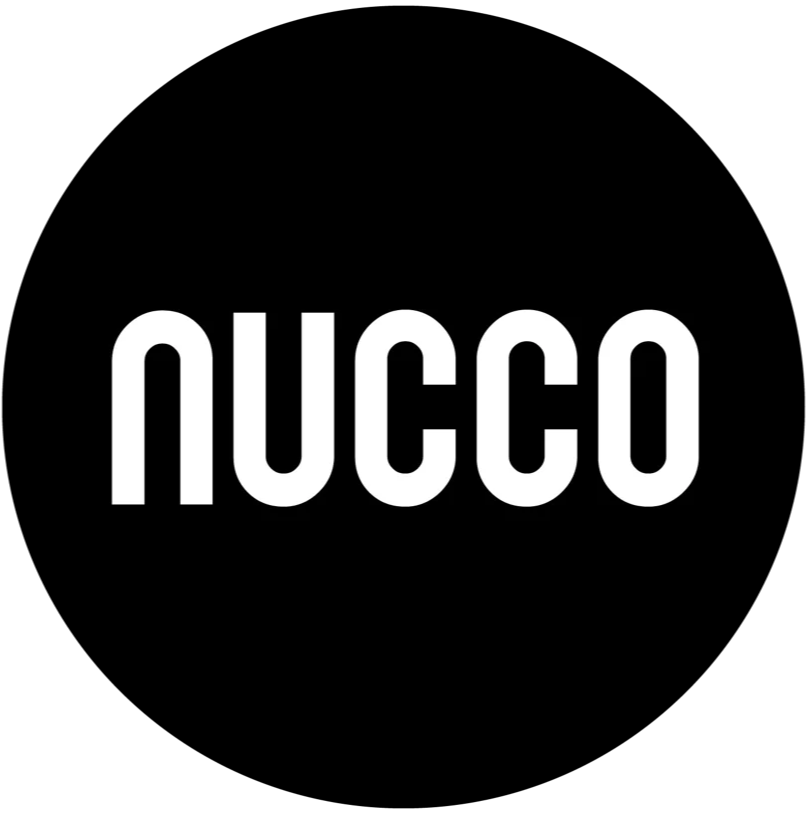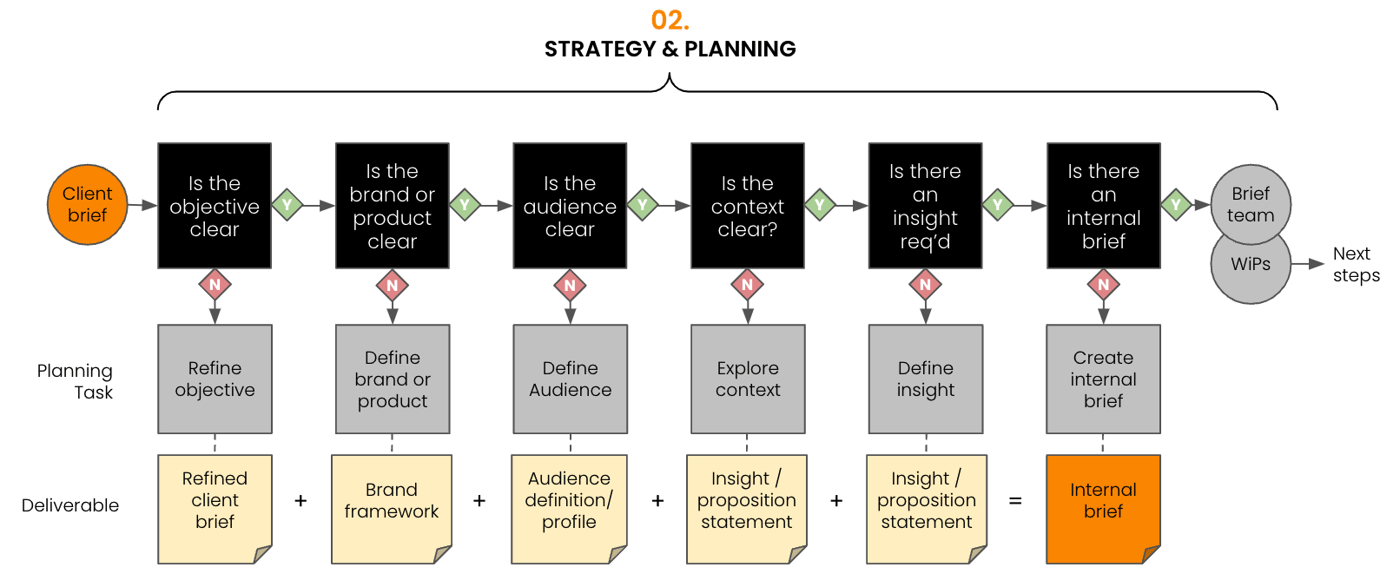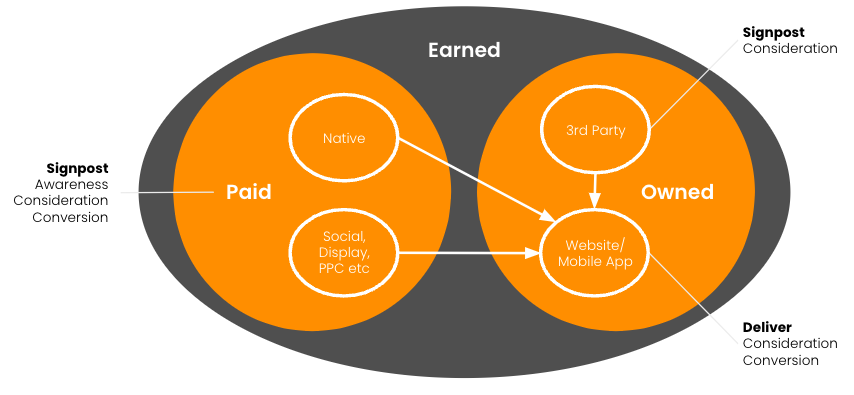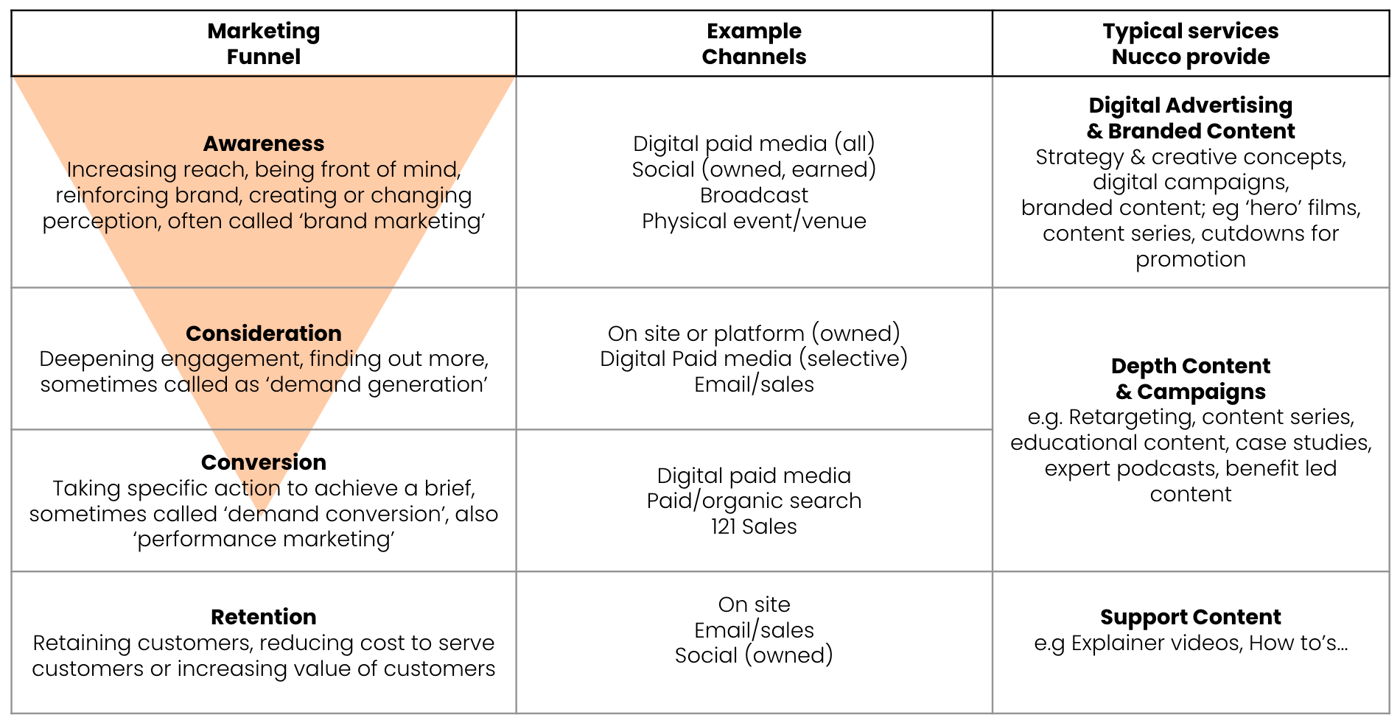S1E2: STRATEGY AND PLANNING GUIDE: IS THE OBJECTIVE CLEAR?

Are you sure you know what you’re doing?
By Mark Iremonger, MD & Strategy Partner at Nucco, a UNIT9 company. In previous lives, Mark has been MD of UNIT9, the Head of Digital and Head of Planning at BBDO’s Proximity London, the Chief Strategy Officer, and then CEO at the Hearst Corporation’s iCrossing. Agency strategic lead for P&G, Allianz, Lloyds Banking Group, Royal Mail, J&J and Aviva. Mark has been a member of the British Council’s Creative Industries Advisory Panel, a Vice Chair of BIMA, a member of D&AD, and a board member of Wired Sussex, which promotes digital creativity, innovation and growth.
Episode 2 of this series clarifies some aspects of strategy and planning as it applies to marketing communications. It is helpful to marketers who want to understand the planning process better or make their communications more effective.
I will lay out some broad principles and then take you through a simple step-by-step approach that takes you from a ‘client brief’ to an ‘internal brief’ that can better brief an agency or team tasked with solving a communications task.
In this episode, I will take a look at objectives. The first question to ask yourself when looking at a new brief is:
Is the objective clear?
A communications brief will inevitably have a shopping list of objectives. I’ve learned it can be a thankless task to strip this right back, but that is what we must do, and it is never easy.
“The biggest impact you can have on a brief is to strip a ‘shopping list’ of objectives back to its basics. Easy to say, hard to do.”
Businesses always have overlapping and conflicting needs when it comes to communications. Decoding a longlist word salad of jargon to clarify the brief's core is an essential first step.
Typical briefs include lines like:
- Raise awareness of…
- Engage our customers in…
- New proposition for…
- Drive traffic to…
- Deliver sales of…
- Increase web sales...
- Increase share of voice…
or…
- A campaign that includes X for Y on Z
where...
- X can = strategy, proposition, insight, concept, user/customer journeys, WOW!, digital assets, video, animation, content, creative
- Y can = customers, products, services, brand
- Z can = display, social, TV, OOH, our website, our social channels, owned channels, paid media
Here’s an extract from a communications brief received from a global business.
- We want to inspire the public to get behind SECTOR SPECIFIC issues.
- Reflect the organisation today, including our leading strengths across our capabilities, as well as our evolving positioning in SECTOR
- Speak more effectively to our rapidly-expanding X CUSTOMER, as well as our strong Y heritage
- Bring to the forefront BRAND’S leading capabilities and innovation in SERVICE, as well as our ability and commitment as a large-scale PRODUCT PRODUCER to drive real change through stewardship and engagement
- Position BRAND as a leading provider of PRODUCT
- Build awareness and increase visibility for PRODUCT in core markets
The idea of one simple, clearly stated, measurable objective is essential to creating ‘work that works’. Hence, this is an exercise in clarification and compromise.
It is worth tackling this through three steps:
- Orientate
- Prioritise
- Define
1. Orientate
First, you must establish a shared understanding of the digital landscape and where your campaign will likely live. The most straightforward approach is to use the well-established paid, owned and earned model.
Paid
Paid is any media you pay for. It includes paid social (ads on social media platforms like Facebook, LinkedIn and TikTok), display (banners on ad networks like Google’s Display Network (GDN)) and paid search (often called PPC or SEM). There are lots of paid media platforms and options. Native refers to ads closely integrated into a platform’s editorial content. Sometimes they do not support an overt ‘next step’ in a digital journey. Paid media works across the marketing funnel and is weighted to the top, awareness and bottom; conversion (mainly via paid search and product ads).
Owned
Owned is anything a business or brand has direct control over. So their social accounts, website, mobile apps, and email are all ‘owned’, where we want customers to encounter ‘depth’ content and experiences, allowing people to dig deeper into subject areas.
Earned
Earned is exposure or reach through word of mouth; traditionally, in pubs and cafes, these days, the focus is social media. ‘Earned’ should be treated as a bonus outcome, so if you have a client expecting you to ‘create something viral’ or ‘blow the doors off social media’ you need to step in with expectation management and look for the actual objective you need to achieve.
The ideal is to plan work that relies on something other than earned spread; if your campaign is good, resonates with your audience or is useful or entertaining to them, it is more likely to be shared.
Now that you have a basic orientation of the landscape you are operating in, you can consider what the brief asks you to do.
2. Prioritise
Start by bucketing the high-level objective. Is awareness really about ‘front of mind’ or is the client using it as a proxy for driving traffic to a website, and is that a proxy for increasing sales? It can be helpful to think about this through a marketing funnel.
Often (particularly in digital briefs), the answer is ‘through the funnel’.
What I mean by this is that clients need to raise awareness, increase traffic, and create conversion events all at once, so it is the strategist's job to prioritise and define these. If you are dealing with a multi-part campaign with separate objectives, consider planning and briefing them separately.
“When exploring a brief, the most important question to answer is ‘why?’”
Start by clarifying which part of the brief is most important. In the client brief below, I have grouped the different parts of the client brief by position in the funnel.
TOP
-
- We want to inspire the public to get behind SECTOR SPECIFIC issues.
- Reflect the organisation today, including our leading strengths across our capabilities, as well as our evolving positioning in SECTOR
- Speak more effectively to our rapidly-expanding X CUSTOMER, as well as our strong Y heritage
- Bring to the forefront BRAND’S leading capabilities and innovation in SERVICE, as well as our ability and commitment as a large-scale PRODUCT PRODUCER to drive real change through stewardship and engagement
- Position BRAND as a leading provider of PRODUCT
- Build awareness and increase visibility for PRODUCT in core markets
MIDDLE
-
- Nothing
BOTTOM
-
- Nothing
This looks like it is a top-of-the-funnel awareness campaign, right? Well, it turned out it was not. When you first explore a brief, the most important question to ask is why? With this brief, it became clear that the client needed to drive traffic to their website and get visitors to share contact information so they could be passed to the sales team as a lead. In fact, it is a conversion brief with a data capture objective.
Consideration and Conversion - First off, explore if there is a specific event your client is trying to trigger. Online this is most likely to be data capture (user hand raises by sharing information), downloads (e.g. a white paper or PDF), or transacts (purchases online). Once you have established this, you can start to explore what success looks like, for example, X downloads, +10% incremental sales etc. This allows you to start attaching value to the work you propose. It sounds simple but gets complicated quickly, and the strategist's job is to make it as simple as possible.
“If you just want ‘drive traffic’ as your key measure of success, the simple way would be to give away a luxury car in a free prize draw on your website. This would certainly drive traffic, but not quality. As the strategist, you need to push for a better KPI.”
Without getting dragged down a rabbit hole of metrics here, there are perhaps six Consideration and Conversion KPIs (Key Performance Indicators) to consider; Traffic, Dwell time, Bounce Rate, Downloads, Transactions, Registrations or possibly CPC (useful glossary here).
Awareness - this should equate directly to being ‘front of mind’. In marketing terms, this is the ‘top of the funnel’. Broadcast TV has dominated this for decades, although we now see more awareness activity in digital like YouTube, Facebook and TikTok etc.
Many businesses do not have a framework to measure brand awareness. They tend to use models that benchmark over time and track broad trends. They are often enterprise-level solutions for consumer brands who spend on broadcast media. While useful to CMOs, they don’t help you measure the effectiveness or success of your brief.
You need to be aware of some KPIs as part of a top-of-the-funnel campaign. Many reflect how well a media planning and buying agency has performed rather than how effective your creative campaign is.
Media planning and buying efficiency KPIs include; Visibility/Viewability, impressions, CPC; Cost Per Click, CTR; Click Through Rate, CPM; Cost per Mille and ROAS; Return on Advertising Spend.
A challenge with many of these is that if you spend more you achieve more, so the focus shifts to the ‘efficiency of spend’, e.g. how many Xs happen for Y amount of cash spent on paid media, rather than the effectiveness of the work.
If you are tackling a brief about awareness, clients and agency people often look to ‘traffic’ as a measure of success. Technically this is wrong because it requires action on behalf of the audience (e.g. to click through etc.). Where you can, avoid this as it takes your eye off what is essential in an awareness brief.
The following three metrics have much more potential as a success metric for awareness:
-
- Comparison to benchmarks for similar sectors and media formats.
- ROI; Return on Investment - generally includes the creative and production costs of the campaign to reflect a ‘real world return’ on dollars spent by a business
- SOV; Share of Voice - can be a useful measure, for example, by tracking share of search around particular keywords
It can often be helpful to introduce an ‘Index’ score that can combine other metrics to track performance over time of your campaign.
Once you have prioritised objectives and explored how to measure them, you can define them.
3. Define
Once you better understand the landscape the brief operates in, you’ve asked ‘why?’ a lot and thought about the marketing funnel, priorities and KPIs you need to get it on a single page.
For example:
ORIGINAL CLIENT BRIEF OBJECTIVES
-
- We want to inspire the public to get behind SECTOR SPECIFIC issues.
- Reflect the organisation today, including our leading strengths across our capabilities, as well as our evolving positioning in SECTOR
- Speak more effectively to our rapidly-expanding CUSTOMER X, as well as our strong Y heritage
- Bring to the forefront WIDGET’S leading capabilities and innovation in SERVICE, as well as our ability and commitment as a large-scale PRODUCT PRODUCER to drive real change through stewardship and engagement
- Position BRAND as a leading provider of PRODUCT
- Build awareness and increase visibility for PRODUCT in core markets
Rewrite 1
A CLEAR CONVERSION OBJECTIVE
This version recognises that the brief is about sales leads.
PRIMARY OBJECTIVE
Create qualified leads for PRODUCT
WHAT SUCCESS LOOKS LIKE (VALIDATION METHOD):
Contact requests via the website form here: www.brand.com/product/contact
SECONDARY OBJECTIVES
Reach and engagement with CUSTOMER X about PRODUCT
SCOPE
This is a full-funnel digital marketing brief using paid media supported by owned channels using content on the brand website and social media to increase contact requests on an existing page outside scope.
If the sales process was essentially offline, this could easily be an awareness brief which would look more like this:
Rewrite 2
A CLEAR AWARENESS OBJECTIVE
PRIMARY OBJECTIVE
Increase reach of BRAND PRODUCT to CUSTOMER X
WHAT SUCCESS LOOKS LIKE (VALIDATION METHOD):
Outperform industry benchmarks for paid media
SECONDARY OBJECTIVES
Traffic to website
SCOPE
This is a digital paid media awareness campaign.
You can see how these different objective statements would lead to very different campaigns and work, even though they are based on exactly the same client brief.
It can be useful to ‘nest’ objectives, which means prioritising them based on ‘to achieve x we need to achieve y’. In the example above, to create the required contact requests, we need to have more people hear about our client’s brand. This means raising awareness is required (a secondary objective) to create traffic, to engage with content (a secondary objective) that we hope will create a conversion (primary objective).
Once you have made your objective as clear as possible, you can get on to the really rewarding parts of strategy and planning, which is to dig into understanding the brand or product, the audience, and planning customer journeys.
If you missed S1E1: Strategy and Planning Guide: First Principles you can view it here
I hope you enjoy the series, please feel free to message me directly with your thoughts and comments at mark.iremonger@nuccobrain.com
The next article in this series is S1E3: Defining the brand or product.






